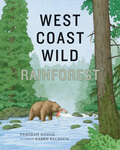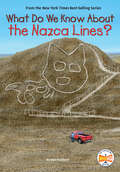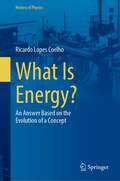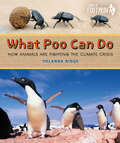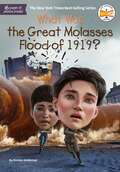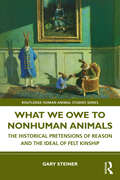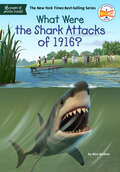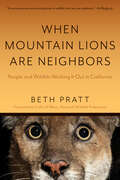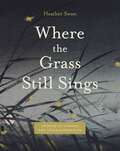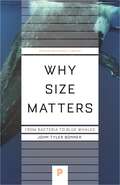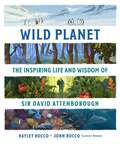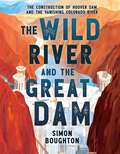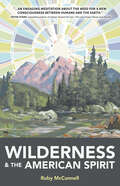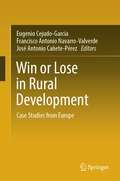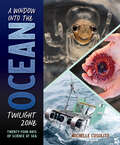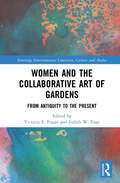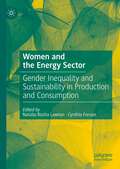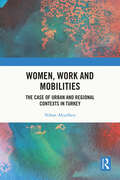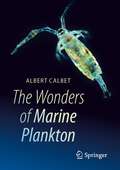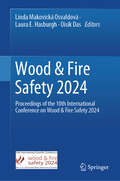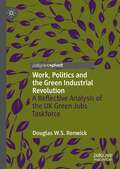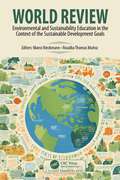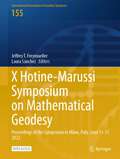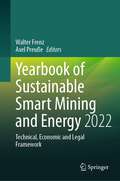- Table View
- List View
West Coast Wild Rainforest (West Coast Wild #5)
by Deborah HodgeStep into the majestic rainforest of the Pacific west coast and discover a unique community of creatures thriving in an interconnected web of life. Towering over the sea, along the magnificent Pacific west coast, is an ancient and beautiful rainforest with a unique ecosystem that is linked in many ways. In this fourth book in the West Coast Wild series, you will find trees as tall as twenty-storey buildings, tiny seedlings sprouting on nursery logs and brightly colored salmon spawning in streams. The salmon, as a keystone species, connect the ocean to the forest and provide a rich source of food for the bears, wolves, eagles and other creatures that live in this pristine wilderness. The remains of the fish add vital nutrients to the forest, feeding the lush green plants and trees. In turn, the thick vegetation shades the streams and protects the baby salmon that hatch and swim to the sea. Author Deborah Hodge provides a clear and engaging look at the interdependence of the forest species and the fascinating cycles of nature in this rare ecosystem, while Karen Reczuch’s lavish watercolors show the rainforest teeming with life in shades of green that can only come from receiving more than ten feet of rain a year. Key Text Features illustrations author’s note further information further reading facts Correlates to the Common Core State Standards in English Language Arts: CCSS.ELA-LITERACY.RI.K.3 With prompting and support, describe the connection between two individuals, events, ideas, or pieces of information in a text. CCSS.ELA-LITERACY.RI.K.7 With prompting and support, describe the relationship between illustrations and the text in which they appear (e.g., what person, place, thing, or idea in the text an illustration depicts). CCSS.ELA-LITERACY.RI.1.3 Describe the connection between two individuals, events, ideas, or pieces of information in a text. CCSS.ELA-LITERACY.RI.1.4 Ask and answer questions to help determine or clarify the meaning of words and phrases in a text.
What Do We Know About the Nazca Lines? (What Do We Know About?)
by Ben Hubbard Who HQHow did the mysterious images high in the Nazca Desert in Peru come to be? Find out the truth about these ancient figures in the soil that can only be fully seen from high above the Nazca plain.Presenting What Do We Know About?, an exciting extension of the #1 New York Times Best-Selling Who Was? series!The Nazca Lines in Peru have mystified people around the world for centuries. The famous figures, sometimes called geoglyphs, include a hummingbird, a spider, a fish, a monkey, a dog, a cat, human-like figures, geometric designs, and more. These amazing images were believed to have been created between 500 B.C.E. and 500 C.E., and no one is quite sure how or why they were created. Some historians believe that they are ancient irrigation systems, but other researchers believe in a more paranormal origin story. Were the Nazca Lines created by ancient cultures thousands of years ago, or could they have been alien landing sites? Find out the truth about the Nazca Lines in this book for young readers.
What Is Energy?: An Answer Based on the Evolution of a Concept (History of Physics)
by Ricardo Lopes CoelhoThis book provides a solution to the problem with the energy concept. This problem manifests itself in the fact that physicists clearly diverge regarding the question of what energy is. Some define it but others state that we do not know what it is. Although this is a problem for physicists who need to explain the concept, it is not a problem for physics that can be solved by laboratory means. Penetrating into the origin of the notion of energy, this book offers a clear idea of what was discovered and what was invented to interpret the findings.Following the development of the concept, it provides an explanation of the trends in contemporary textbooks. The author's repetition, in his "History and Philosophy of Physics Laboratory", of Joule’s famous experiment – the paddle wheel experiment – with a calorimeter as originally used by Joule and with a calorimeter as proposed in textbooks, is presented, yielding new insight into the phenomenon. Thus, science teachers and students will benefit from reading the book as well as historians, philosophers, students of the history and philosophy of science, and all who are interested in knowing about what it is that we call energy.
What Poo Can Do: How Animals Are Fighting the Climate Crisis (Orca Footprints #29)
by Yolanda RidgeWe all know animals are affected by the climate crisis. But did you know the climate crisis is also affected by animals? From whales to dung beetles, What Poo Can Do explores how animals big and small are helping the planet every time they do a number two. Come on a journey to different parts of the world to see how animals are fertilizing plants, storing carbon, preventing fires, reducing methane and even creating color-coded maps—all through their feces! Readers will discover how animal defecation makes a difference when it comes to the climate crisis. It's time to embrace the power of poo!
What Was the Great Molasses Flood of 1919? (What Was?)
by Kirsten Anderson Who HQLearn about Boston's molasses disaster of 1919, when a storage tank burst and flooded the streets, in this latest addition to the New York Times Bestselling What Was? series.An unusually warm winter day resulted in 2.3 million gallons of molasses flooding the North End neighborhood of Boston, Massachusetts. The disaster killed twenty-one people and injured 150 others. Rescue missions were launched to save people from the sticky and deadly mess, led by the Red Cross, the Army, the Navy, and the Massachusetts Nautical School. With the help of hundreds of volunteers over the course of several weeks, the streets were cleaned up. But the smell of molasses and the horror of the preventable tragedy lingered for decades to come.
What We Owe to Nonhuman Animals: The Historical Pretensions of Reason and the Ideal of Felt Kinship (Routledge Human-Animal Studies Series)
by Gary SteinerThis book strongly challenges the Western philosophical tradition's assertion that humans are superior to nonhuman animals. It makes a case for the full and direct moral status of nonhuman animals. The book provides the basis for a radical critique of the entire trajectory of animal studies over the past fifteen years. The key idea explored is that of ‘felt kinship’—a sense of shared fate with and obligations to all sentient life. It will help to inspire some deep rethinking on the part of leading exponents of animal studies. The book's strong outlook is expressed through an appeal for radical humility on the side of humans rather than a constant reference to the ‘human-animal divide’. Historical figures examined in depth include Aristotle, Seneca, and Kant; contemporary figures examined include Christine Korsgaard and Martha Nussbaum. This book presents an account according to which the tradition has not proceeded on the basis of impartial motivations at all, but instead has made a set of pointedly self-serving assumptions about the proper criteria for assessing moral worth. Readers of this book will gain exposure to a wide variety of thinkers in the Western philosophical tradition, historical as well as contemporary. This book is suitable for professionals working in nonhuman animal studies, students, advanced undergraduates, and practitioners working in the fields of philosophy, environmental studies, law, literature, anthropology, and related fields.
What Were the Shark Attacks of 1916? (What Was?)
by Nico Medina Who HQThe panic-filled summer of 1916, when multiple deadly shark attacks shocked the nation, is chronicled in this gripping addition to the New York Times Best-Selling What Was? series.On July 1, 1916, witnesses watched in horror as twenty-eight-year-old Charles Vansant was attacked and killed by a shark in shallow water off Beach Haven, New Jersey—the first recorded shark attack in American history. Scientists claimed a shark could not be responsible, but more deadly attacks soon followed along the Jersey Shore and up the freshwater Matawan Creek, setting off a nationwide panic that led the White House to declare a &“War on Sharks.&” In this illustrated book, which features 16 pages of black-and-white photographs, readers will learn about the likely culprit (or culprits) in the attacks—the great white shark and the bull shark—and how the bloody summer of 1916 would change how people viewed sharks forever.
When Mountain Lions Are Neighbors: People and Wildlife Working It Out in California (With a New Preface)
by Beth PrattNow updated with a new preface: a full-color celebration of coexistence with California's iconic wildlife.Wildness beats in the heart of California's urban areas, and across the state Californians are taking action to recast wildlife as an integral part of our everyday lives. In Los Angeles, residents rallied to build one of the largest wildlife crossings in the world because of the plight of one lonely mountain lion named P-22. Porpoises cavort in San Francisco Bay again because of a grassroots effort to clean up a waterway that was once a toxic mess. Yosemite's park staff and millions of visitors have mobilized to keep its famed bears wild. And after a near century-long absence, Californians are welcoming wolves back to the state, inspired by the remarkable journey of the wolf OR-7. When Mountain Lions Are Neighbors explores this evolving dynamic between humans and animals. Now updated with a new preface, these inspiring stories celebrate a new model for wildlife conservation: coexistence.
Where the Grass Still Sings: Stories of Insects and Interconnection (Animalibus)
by Heather SwanThrough narrative, verse, and art, Where the Grass Still Sings celebrates the many tiny creatures that play crucial roles in our ecosystems—as well as the people on the front lines of the fight to save them.Weaving art and science with inspiring stories of people doing their part to protect insects and the environment, author Heather Swan takes readers around the globe to highlight practical solutions to safeguard our fragile planet. Visit a sustainable coffee farm in Ecuador and a frog expert combating animal trafficking in Colombia. Explore a butterfly sanctuary in an Andean cloud forest and learn about a family of orchid farmers who are replanting a mountainside to attract native pollinators. Meet a bumblebee expert helping Wisconsin cranberry growers, a bark beetle specialist in a new-growth forest in Georgia, an entomologist collecting for the Essig Museum in California, and more. Against a backdrop of climate change, ecological injustice, and impending mass extinction, this book rekindles wonder and hope.Featuring works by artists deeply invested in preserving the smallest beings among us, Where the Grass Still Sings is a paean to the natural world.
Why Size Matters: From Bacteria to Blue Whales (Princeton Science Library #142)
by John Tyler BonnerJohn Tyler Bonner, one of our most distinguished and creative biologists, here offers a completely new perspective on the role of size in biology. In his hallmark friendly style, he explores the universal impact of being the right size. By examining stories ranging from Alice in Wonderland to Gulliver's Travels, he shows that humans have always been fascinated by things big and small. Why then does size always reside on the fringes of science and never on the center stage? Why do biologists and others ponder size only when studying something else—running speed, life span, or metabolism?Why Size Matters, a pioneering book of big ideas in a compact size, gives size its due by presenting a profound yet lucid overview of what we know about its role in the living world. Bonner argues that size really does matter—that it is the supreme and universal determinant of what any organism can be and do. For example, because tiny creatures are subject primarily to forces of cohesion and larger beasts to gravity, a fly can easily walk up a wall, something we humans cannot even begin to imagine doing.Bonner introduces us to size through the giants and dwarfs of human, animal, and plant history and then explores questions including the physics of size as it affects biology, the evolution of size over geological time, and the role of size in the function and longevity of living things.As this elegantly written book shows, size affects life in its every aspect. It is a universal frame from which nothing escapes.
Wild Planet: The Inspiring Life and Wisdom of Sir David Attenborough
by Hayley RoccoA fascinating picture book biography of broadcaster and biologist, Sir David Attenborough'A beautiful book with a timely message accessible for all ages.' Rick Riordan, bestselling author of the Percy Jackson and the Olympians seriesAs a boy, David loved exploring the wild places near his home. When he was older, he travelled the world to film animals in their natural habitats. His adventures brought the wonders of the world into our homes. But David also noticed that our planet was changing. What could David do to help? What could we all do? This is the inspiring story of Sir David Attenborough. It&’s also the story of our planet and an urgent call for us to do our part to protect our planet and the creatures who call Earth home. 'Nothing short of stunning.' Sherri Duskey Rinker, #1 New York Times bestselling author of Steam Train, Dream Train
The Wild River and the Great Dam: The Construction of Hoover Dam and the Vanishing Colorado River
by Simon Boughton★ "In this detailed and informative work, Boughton chronicles the construction of the Hoover Dam via compellingly comprehensive text." —Publishers Weekly, starred review ★ "This well-written narrative is bound to become the authority on this modern American marvel." —Booklist, starred review"A fascinating blend of social and environmental history and engineering." —Kirkus Reviews "Truly breathtaking. This is a powerful story and like the water slowly rising behind that concrete barrier, it becomes more powerful with each page turn." —David Macaulay, two-time recipient of the Caldecott Medal and creator of the bestselling The Way Things Work"An exciting mix of research, storytelling, and an astounding true story—one that&’s still unfolding today." —Steve Sheinkin, three-time National Book Award finalist and Newbery Honor author of Bomb Discover the complicated history behind the construction of Hoover Dam—one of the country&’s most recognizable and far-reaching landmarks—and its lasting political and environmental effects on the Colorado River and the American West. At the time of its completion in 1936, Hoover Dam was the biggest dam in the world and the largest feat of architecture and engineering in the country—a statement of national ambition and technical achievement. It turned the wild Colorado River into a tame and securely managed water source, transforming millions of acres of desert into farmland while also providing water and power to the fast-growing population of the Southwest. The concrete monolith quickly became a symbol of American ingenuity; however, its history is laden with contradiction. It provided work for thousands, but it was a dangerous project that exploited desperate workers during the Depression. It helped secure the settlement and economies of the Southwest, but at the expense of Indigenous peoples and the environment; and it created a dependency on the Colorado River&’s water, which is under threat from overuse and climate change. Weaving together elements of engineering, geography, and political and socioeconomic history, and drawing heavily from unpublished oral histories taken from dam workers and their families, Simon Boughton&’s thoughtful and compelling debut—featuring historical photographs throughout—follows the construction and impact of Hoover Dam, and how its promise of abundance ultimately created a river in crisis today.A Junior Library Guild Gold Standard Selection
Wilderness and the American Spirit
by Ruby McConnellTHE IDEA OF THE AMERICAN SPIRIT has always been rooted inexpansion and abundance— at great cost to the environment. Withthe world burning up, one can' t help but wonder: how did we gethere? Wilderness and the American Spirit traces hundreds ofyears of The United States' relationship to the environment starting fromthe initial colonization of Native American land, to the developmentof land use policies, and the creation of resource based economies.Using a lesser known alternative to the Oregon Trail— Ruby McConnelluses the Applegate Trail as a vehicle to weave exposition, history, andscience to show us how we got to where we are now and what wecan do about it.
Win or Lose in Rural Development: Case Studies from Europe
by Eugenio Cejudo-García Francisco Antonio Navarro-Valverde José Antonio Cañete-PérezThe aims of this book are: systematization and theorization of these projects; clarify and deepen the social and territorial effects of these initiatives; in-depth study of the causes that lead to the generation of successful projects in rural development; and abound in the reasons that lead specific projects to be failed in the access to LEADER support and be finally not implemented. This process of systematization and theorization would contribute to improving the decision-making in rural development, concretely the practice of these policies and initiatives. The book shows the problems, results and best practices that cause the rural development in different areas along with Europe. The multidisciplinary and international character of the authors in the analysis of rural development will enrich the publication and facilitate the different and critical reflections on the contributions, errors and meaning of these rural development practices.
A Window into the Ocean Twilight Zone: Twenty-Four Days of Science at Sea
by Michelle CusolitoWant a front-row seat to cutting-edge ocean twilight zone technology? Climb aboard for twenty-four days of photo-illustrated science at sea! A fascinating middle-grade STEM book.Join scientists from Woods Hole Oceanographic Institution (WHOI) and international partner organizations on a research trip to study the ocean twilight zone using the newest technologies. Science writer Michelle Cusolito takes you along for the voyage of a lifetime. From moving onto the ship and unpacking equipment to facing massive storms while in the middle of the Atlantic Ocean, this book details the fascinating equipment used to study the deep ocean as well as day-to-day details such as what you eat on a Spanish research ship. Meet people and animals and learn more at sea than you ever imagined!&“From word one, Cusolito puts the reader smack into the action. Captivating creatures abound, coupled with important insights that impact our understanding of the ocean&’s role in our planet&’s sustainability. Perfectly titled, this book throws a window wide open, giving us an intimate look into the twilight zone.&” —Tanya Lee Stone, Sibert Medalist & NAACP Image Award Winner&“Michelle Cusolito captures the essence of high-seas research in A Window into the Ocean Twilight Zone. She skillfully guides the reader through what it&’s like to be a scientist at sea—the anticipation of departure, the challenges of heavy weather, and the thrill of discovery in one of the ocean&’s most remote and mysterious regions. In the process, she underscores the urgency behind advancing knowledge of Earth&’s last frontier—the ocean.&”—Peter de Menocal, President and Director of the Woods Hole Oceanographic Institution&“This spellbinding, real-life adventure will whisk you away with a team of scientists as they explore the wonders of the twilight zone. Michelle is a perfect guide to this remote realm and brilliantly shows what it's like to be a scientist working in challenging conditions. You&’ll learn about the importance of teamwork and patience, find out about the exciting technologies scientists use to study the deep sea, and see how discoveries about our living planet are made. This book will spark curiosity and is perfect for budding scientists.&”—Dr. Helen Scales, marine biologist and author of books for kids and adults, including What a Shell Can Tell and The Brilliant Abyss
Women and the Collaborative Art of Gardens: From Antiquity to the Present (Routledge Environmental Literature, Culture and Media)
by Victoria E. Pagán Judith W. PageWomen and the Collaborative Art of Gardens explores the garden and its agency in the history of the built and natural environments, as evidenced in landscape architecture, literature, art, archaeology, history, photography, and film. Throughout the book, each chapter centers the act of collaboration, from garden clubs of the early twentieth century as powerful models of women’s leadership, to the more intimate partnerships between family members, to the delicate relationship between artist and subject. Women emerge in every chapter, whether as gardeners, designers, owners, writers, illustrators, photographers, filmmakers, or subjects, but the contributors to this dynamic collection unseat common assumptions about the role of women in gardens to make manifest the significant ways in which women write themselves into the accounts of garden design, practice, and history. The book reveals the power of gardens to shape human existence, even as humans shape gardens and their representations in a variety of media, including brilliantly illuminated manuscripts, intricately carved architectural spaces, wall paintings, black and white photographs, and wood cuts. Ultimately, the volume reveals that gardens are best apprehended when understood as products of collaboration. The book will be of interest to scholars and students of gardens and culture, ancient Rome, art history, British literature, medieval France, film studies, women’s studies, photography, African American Studies, and landscape architecture.
Women and the Energy Sector: Gender Inequality and Sustainability in Production and Consumption
by Natalia Rocha Lawton Cynthia ForsonThis book explores the relationship between gender inequality and the energy business, examining how gender relates to the process of producing energy, the management of energy companies, and the consumption of energy in the public and private sphere. Drawing on a wide range of examples, from Africa, South Asia, Latin America and Europe, it examines how clean energy targets can transform the experience of women in the workplace, creating new opportunities and challenges. This book knits together a variety of voices probing continuing and emerging gender inequality in energy, from a number of perspectives, geography, energy dimensions, environment, socio-political and economic contexts. Its multidimensional approach provides a textured analysis of women’s experiences in the energy landscape, and proffers solutions for addressing the universality, yet contextually disparate impacts, of patriarchy and its intersections with another strands of inequality. It will be of great interest to academics studying energy capitalism, energy production, consumption, public policy and gender studies, as well as those practitioners and policymakers in the energy industry and relating to gender and equality in the workplace.
Women, Work and Mobilities: The case of urban and regional contexts in Turkey
by Nihan AkyelkenThis book explores the wider implications of how workers move within and across cities and regions to reach economic opportunities. It does so with a specific focus on women in urban and regional contexts in Turkey. The book reveals specificities and generalisations about mobility patterns of women in low-income households/low-paid jobs and how these change in the existence of urban and regional interventions, such as industrial zoning, urban transformations and mobility restrictions. The book presents new theorisations of work and mobility through labour agency, showing how mobility changes the recruitment and use of labour under state interventions. It orchestrates the existing narratives of containment, mobility and rootedness to shed light on the role of labour agency in organising livelihoods. The book particularly acknowledges the multiscale, multifaceted and relational nature of mobilities entailed in the economy by bringing the role of labour agency into urban and regional contexts. This book will appeal to researchers and students working on labour geography, feminist geography, mobilities and urban studies.
The Wonders of Marine Plankton
by Albert CalbetMarine plankton, despite their tiny size, are crucial for the functioning of marine food webs. It is not just about one organism eating another; when this happens, it helps release the nutrients accumulated within living matter, making them available again for microalgae. Plankton are present in freshwater and in all the seas and oceans on the planet. Moreover, they are responsible for supporting life on Earth and has provided us (on geological timescales) with a significant portion of the oxygen we breathe. In just a small spoonful of seawater, we can find around fifty million viruses, five million bacteria, hundreds of thousands of small unicellular flagellates, thousands of microscopic algae, five heterotrophic ciliates or dinoflagellates, and, with some luck, a small crustacean like copepods. This book aims to bridge the gap between scientific research and the general public, offering a captivating exploration of the fascinating world of marine plankton. Through engaging narratives and visually compelling illustrations, readers will gain insights into the importance of plankton in marine ecosystems, their diverse forms, and the crucial role they play in maintaining our planet's health.
Wood & Fire Safety 2024: Proceedings of the 10th International Conference on Wood & Fire Safety 2024
by Oisik Das Linda Makovická Osvaldová Laura E. HasburghThis proceedings volume presents new scientific works of the research workers and experts in the field of Wood Science & Fire.It looks into the properties of various tree species across the continents affecting the fire-technical properties of wood and wood-based materials, its modifications, fire-retardant methods and other technological processes that have an impact on wood ignition and burning. The results of these findings have a direct impact on Building Construction and Design describing the fire safety of wooden buildings, mainly large and multi-story ones. The results of these experiments and findings may be applied, or are directly implemented into Fire Science, Hazard Control, Building Safety which makes the application of wood and wood materials in buildings possible, while maintaining strict fire regulations.One part of the contributions focuses on the symbiosis of the material and the fire-fighting technologies. Wood burning has its own specific features, therefore, the fire protection technologies need to be updated regularly. It also includes the issue of the intervention of fire-fighting and rescue teams in the fires of wooden buildings. Presentations deal with the issue of forest fires influenced by the climate changes, relief, fuel models based on the type and the age of the forest stand.
Work, Politics and the Green Industrial Revolution: A Reflective Analysis of the UK Green Jobs Taskforce
by Douglas W.S. RenwickIn 2020, UK Prime Minister Boris Johnson launched The Green Jobs Taskforce, which extended and articulated the green jobs policy of his government and its position within conservative political ideology. This book critically highlights gaps in the political and business decision-making of his Taskforce, most notably on: the limited role of employers and HRM associations in skills building for staff in non-polluter industries (solar and wind); issues of a fair and just transition for workers losing jobs in the polluter industries (fossil fuels); and the lack of employee voice in both work arenas. The overtly pro-conservative and political nature of this UK Taskforce is also analyzed, which occurs and operates in opposition to British trade unions and the wider labor movement, by not prioritizing the just transition, alongside the extensive skills, training and passporting requirements that British workers need to gain decent, green jobs.This book is distinctive in offering the first in-depth analysis and critique of the UK Green Jobs Taskforce, in examining this Taskforce using conservative political ideas, and by critiquing it too. Little academic literature is available globally on the business impact and analysis of UK governmental sustainability policy, and this study can provide wider learning points, lessons and implications for other green job plans being formed and enacted in the EU, USA and other countries. It will be of great interest to academics and students of sustainability, HRM, organizational behavior, organization studies and employment relations.
The World Is Ours to Cherish: A Letter to a Child
by Mary Annaïse HeglarThis hopeful picture book--written in the style of a letter--gives kids an honest take on climate change and urges them to band together to help the planet.The world is a big, beautiful place full of natural wonders--everything from bees to rainfall can seem magical.The world is also changing. Climate change has already had a devastating effect on the planet.But it's not too late! If we work together and show a little more care, both for the environment and each other, we can keep this world beautiful.This moving debut from climate writer Mary Annaïse Heglar is perfect for budding environmentalists and anyone in need of a little hope for the future of our planet.
World Review: Environmental and Sustainability Education in the Context of the Sustainable Development Goals
by Marco Rieckmann Rosalba Thomas MuñozThe global landscape of education has been reshaped by the COVID-19 pandemic, revealing the various challenges faced by countries worldwide. This book provides a comprehensive exploration of Environmental and Sustainability Education (ESE) across different countries, offering unique insights into their histories, challenges, achievements, and future ESE needs. From Africa to Oceania, the book delves into the vital role of ESE in the context of the UN Sustainable Development Goals. It highlights the diverse national discourses and the flexibility required to deliver effective global education programs. ESE practitioners, researchers, and policymakers worldwide will find inspiration and invaluable perspectives in this book.
X Hotine-Marussi Symposium on Mathematical Geodesy: Proceedings of the Symposium in Milan, Italy, June 13-17, 2022 (International Association of Geodesy Symposia #155)
by Jeffrey T. Freymueller Laura SánchezThis open access volume contains the proceedings of the X Hotine-Marussi Symposium on Mathematical Geodesy which was held from 13 to 17 June 2022 at the Politecnico di Milano, Milan, Italy. Since 2006 the series of the Hotine-Marussi Symposia has been under the responsibility of the Inter-Commission Committee on Theory (ICCT) within the International Association of Geodesy (IAG). The ICCT organized the last five Hotine-Marussi Symposia held in Wuhan (2006), Rome (2009, 2013 and 2018), and Milan (2022). The overall goal of the ICCT and Hotine-Marussi Symposia has always been to advance geodetic theory which is indeed documented by the 22 research articles published in these proceedings. The jubilee X Hotine-Marussi Symposium was organized in 10 topical sessions covering all parts of geodetic theory including reference frames, gravity field modelling, adjustment theory, height systems, time series analysis, or advanced numerical methods. In total, 60 participants attended the Symposium who delivered 62 oral and 18 poster presentations. During a special session, five invited speakers discussed two basic concepts of physical geodesy – geoid and quasigeoid.
Yearbook of Sustainable Smart Mining and Energy 2022: Technical, Economic and Legal Framework (Yearbook of Sustainable Smart Mining and Energy - Technical, Economic and Legal Framework #2)
by Walter Frenz Axel PreußeThis book covers several aspects of the application of Sustainable Development Goals to mining related subjects. The included works range from methods to assess and implement sustainability to discussions of legal impacts and relations as well as technological developments and outlooks. First, the challenges and opportunities of clean energy transition in the African mining sector are described. With regard to the assessment of sustainable developments, this book includes the applications of the sieving method, the concept of thermodynamics and the United Nations Framework Classification to mining projects and case studies. The implementation of Sustainable Development Goals into academic project work and education of geo-engineers is covered as well. The legal topics contain discussions of corporate climate liabilities and extraterritorial legal responsibilities as well as an analysis of the impact of the German Federal Constitutional Court's climate decision. Important mining aspects and technological developments like proactive water management, sustainable approaches to mine closure and implementation of ventilation on demand in underground mines are described. In addition, the state and potential of the Mongolian raw materials industry is covered. The Sustainable Smart Mining and Energy Yearbook is not only aimed at researchers and professionals, but at all who want to get an overview of current important technical and legal topics in this field.
